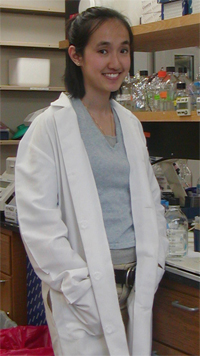Which causes more cancer, UVA or UVB?
Stephanie Gan's research is suggesting that UVA radiation is more dangerous than UVB radiation.

Stephanie Gan, who just completed her first year at Boston University Medical School, has been selected as the 2006 Betty Lea Stone American Cancer Society Junior Research Fellow.
As this year’s Stone Fellow, Gan received a $4,000 grant from the American Cancer Society New England Division to conduct research into the amount of DNA repair that occurs in cells exposed to UVA versus UVB radiation.
In her work, Gan grows keratinocytes, the predominant kind of skin cell that composes the epidermis, and exposes them to varying levels of UVA and UVB radiation. She then looks for a specific protein, P53, whose presence indicates that DNA repair has occurred in the cell. The greater the amount of DNA repair the less likely it is that DNA mutation has occurred, which can lead to cancer.
Gan’s research is a continuation of that completed by her mentor, Professor Thomas Ruenger MD, in 2004. “I’m interested in dermatology and that made me seek out my mentor,” said Gan. “He described the project to me and it caught my interest.”
Though her research will continue through mid-August, Gan has already noticed an interesting trend in her data. “I’ve found that UVA causes less P53 activation and less DNA repair than UVB,” said Gan. This suggests that UVA rays are the more harmful radiation, a distinction that is important for those who frequent tanning salons because tanning beds use UVA.
She hopes that the results of her research will help raise public awareness of the causes of skin cancer and the role UVA plays in cancer development. She also hopes that her work will “help others in some way, not just the general public but the scientific community” to contribute to advances in cancer research and treatment.